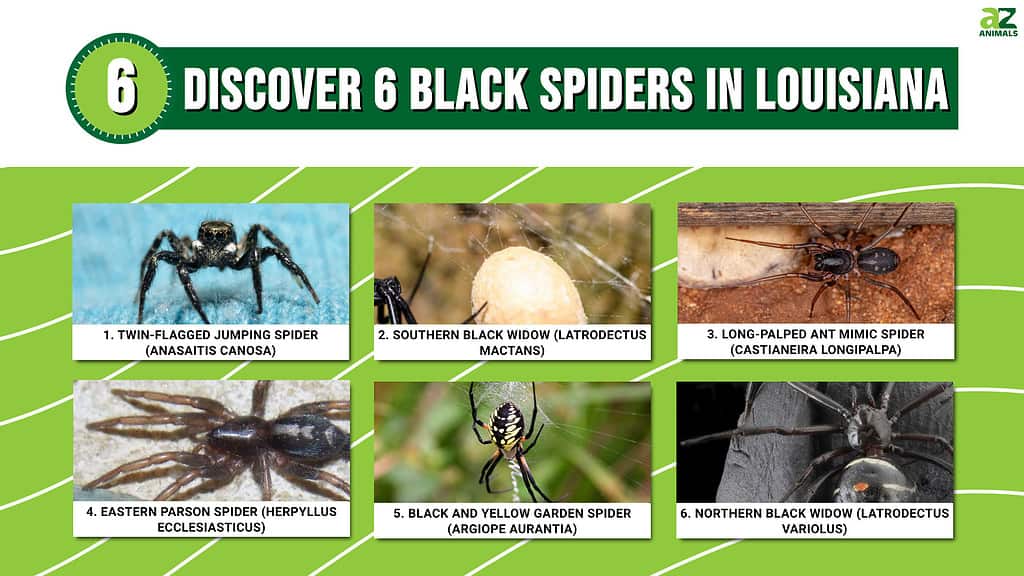
If you were to explore the swamps and bayous of Louisiana, you would likely encounter a number of different black spider species, each with its own distinct characteristics and quirks. Despite their reputation as fearsome predators, black spiders are essential to the Louisiana ecosystem. And while they may be intimidating to some, these spiders are a testament to the power and beauty of nature. In addition, they remind us of the wonders that lie just beyond our doorstep. So let’s take a closer look at some of the fascinating black spider species that call Louisiana home.
1. Twin-Flagged Jumping Spider (Anasaitis canosa)
Twin-flagged jumping spiders are a common sight in Louisiana homes. Their appearance can be quite frightening despite their small size.
The twin-flagged jumping spider is a small arachnid. Its mostly black body is adorned with two or four white markings on its head. While there are some variations in appearance, such as a smaller abdomen, all individuals of this species have a pointed abdomen tip with a white dash at its center. This dash is encircled by a large, perhaps faded, white ring, which may be broken by light-colored chevrons that extend from the dash to the end of the body. The spider’s legs are lighter in color with dark bands.
In adulthood, this spider typically measures between 0.15 and 0.4 inches in length.
Like other spiders belonging to the Salticidae family, the twin-flagged jumping spider does not rely on webs to catch its prey. Instead, it utilizes its exceptional leaping ability to pounce on insects while constantly being on the move. This same ability also aids the spider in escaping from any potential threats or humans who get too close.
This spider species dwells on a variety of surfaces such as the forest floor, rocks, leaf litter, leaves, or stems of plants, as well as artificial objects such as decks. It is not uncommon for these spiders to wander inside buildings.
Studies on the hunting behavior of this species have revealed that they can follow their prey along complex routes. They may even possess the ability to internalize and triangulate the location of their target. The twin-flagged jumping spider feeds on ants and other insects.
Jumping spiders are generally harmless to humans and do not pose a significant threat. They are unlikely to bite unless they perceive a threat to their safety.
Fun Facts
- The twin-flagged jumping spider is a small but agile arachnid.
- This spider can live for up to two years.
- Like many other Salticids, this species employs its silk as a tether while jumping, and if it misses its target, it will climb back up the silk line to its previous position.
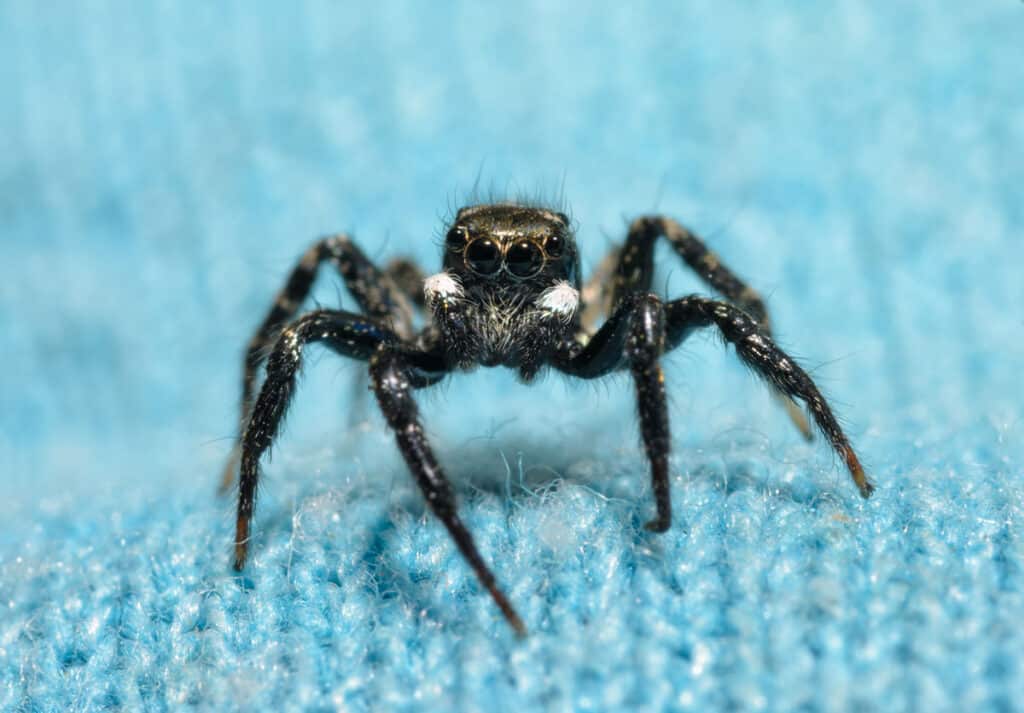
The twin-flagged jumping spider gets its name from the two pennant-shaped markings on its cephalothorax.
©Sari ONeal/Shutterstock.com
2. Southern Black Widow (Latrodectus mactans)
Louisiana is home to the southern black widow. This black spider is the most dangerous spider species in the United States.
The female southern black widow has a glossy and jet-black appearance. Its abdomen’s underside is identifiable by the recognizable orange-to-red hourglass marking. The dorsum is either unmarked or may feature up to four red dots. On the other hand, the male spider is black and has white markings on its underbody, along with red spots.
While the female measures around 3/8 inch in body length, the male is smaller, measuring about 3/16 inch. However, it is worth noting that the spider’s size can vary significantly across different geographical populations.
After mating, females of the southern black widow species kill and consume the male, hence the species name, “widow.” Female southern black widow spiders can survive for up to a year or more. During their lifespan, they can produce up to nine egg sacs. These egg sacs can grow to about 0.5 inches in diameter and contain anywhere between 200 to 800 eggs.
These spiders thrive in various locations, including under stones, woodpiles, or stumps, as well as in the dark corners of barns and garages, unoccupied rodent holes, undisturbed cavities, and outdoor privies.
The southern black widow spider feeds on a diverse array of flying and climbing insects, such as grasshoppers, flies, and other spiders.
A southern black widow spider bite is initially painless due to the neurotoxic venom, but pain may be felt a few hours later. The bite site may exhibit two red fang marks with little to no swelling but may be surrounded by a rash. Within one to three hours, the patient may experience various symptoms, such as chills, muscle aches, and nausea. The symptoms generally dissipate within four days but can last up to a week. While a bite from a black widow spider can be unpleasant, fatalities are rare. However, when you suspect to have been bitten by a southern black widow, it’s best to seek medical attention immediately, as you never know how severely you may react to its venom.
Fun Facts
- Black widow spiders are present in warmer regions worldwide.
- During the summer months, when most southern black widow bites occur, the female spider stands guard over the eggs.
- Male and immature southern black widows lack fangs large enough to penetrate human skin, so they are not capable of biting humans.

Female southern black widow spiders can survive for up to a year or more. During their lifespan, they can produce up to nine egg sacs.
©Jeff W. Jarrett/Shutterstock.com
3. Long-Palped Ant Mimic Spider (Castianeira Longipalpa)
Castianeira Longipalpa is frequently spotted along the eastern coast of North America and can also be found in Louisiana.
The long-palped ant mimic spider displays distinct physical features that vary based on age and gender. Its abdomen is predominantly black, with four lateral stripes that are either white or light gray in color. The cephalothorax, which refers to the spider’s head area, is usually black, brown, or grayish and has a white tinge. Among adults, the first two pairs of legs typically have a brown hue towards the end and are black closer to the body.
Adult females can reach a maximum body size of half an inch, while males are smaller.
Similar to other spiders in the Corinnidae family, this hunting spider doesn’t construct webs to capture prey. Instead, it actively preys on small creatures, particularly ants. The spider solely uses its silk-spinning capabilities to create protective egg sacs to encase its eggs and build a nest to house them.
The long-palped ant mimic spider thrives in habitats close to the ground, such as under rocks, logs, and leaf litter. They prefer wooded areas but also live in grasslands and gardens.
They often mimic carpenter ants by slowly waving their front pair of legs in the air, making it appear as if they were antennae. This helps them get closer to their prey without being detected. These spiders prefer to feed on ants and other small insects.
The venom of the long-palped ant mimic spider is potent enough to kill small insects but is not harmful to humans.
Fun Facts
- Exact identification may require microscopic examination.
- The long-palped ant mimic spider can appear aggressive due to its speed.
- Their small size often makes it challenging for them to pierce through human skin.
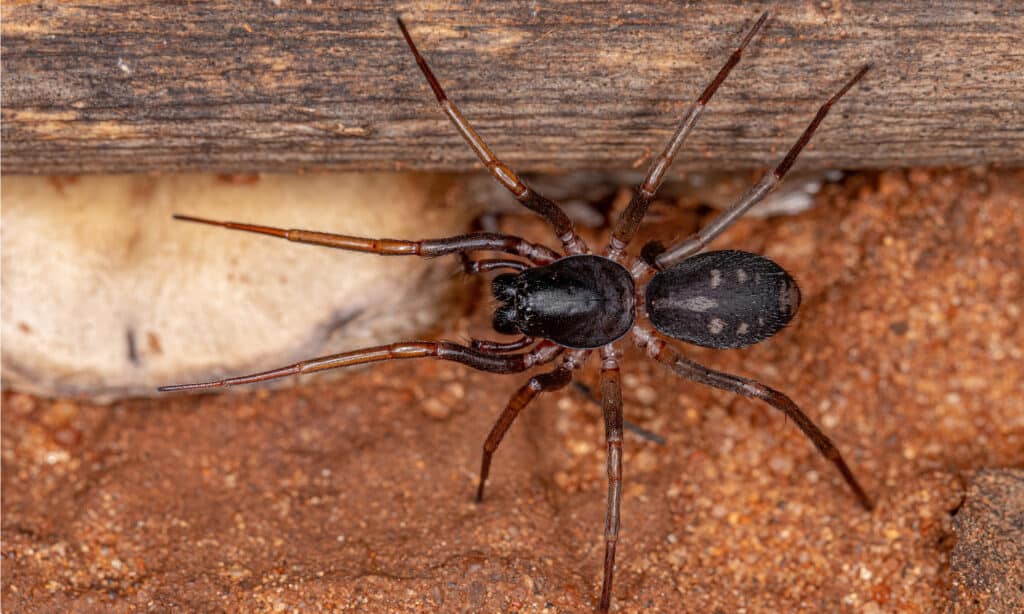
Long-palped ant mimic spiders often mimic carpenter ants by slowly waving their front pair of legs in the air, making it appear as if they were antennae.
©Vinicius R. Souza/Shutterstock.com
4. Eastern Parson Spider (Herpyllus ecclesiasticus)
In Louisiana, encounters with the eastern parson spider are frequent. It is one of the most prevalent spider species in the United States.
The cephalothorax of the parson spider is covered with black hairs, while the abdomen is adorned with gray hairs. A distinguishing feature of this spider is a white mark on its back, which is why it’s commonly known as the “parson spider.” Additionally, there is a small white spot located above its spinnerets.
Measuring approximately 1/2 inch in length, the parson spider can range in color from black to brown.
The eastern parson spider is a member of the ground spider family. It prefers to forage on the ground and walls, primarily at night, seeking out insects as its food source. As an ambush predator, the parson spider swiftly bites any insects it encounters.
These spiders thrive in various habitats, such as inside homes and buildings. They also take shelter under rocks, boards, and other debris.
The eastern parson spider’s diet mainly consists of insects and other spiders.
The bite of an eastern parson spider can be quite painful. Some people may even have an allergic reaction to it.
Fun Facts
- The parson spider’s habitat ranges from Mexico to Canada.
- Its bite has caused allergic reactions in some people.
- While some consider it a nuisance, the eastern parson spider is beneficial to have around as it feeds on common household pests.
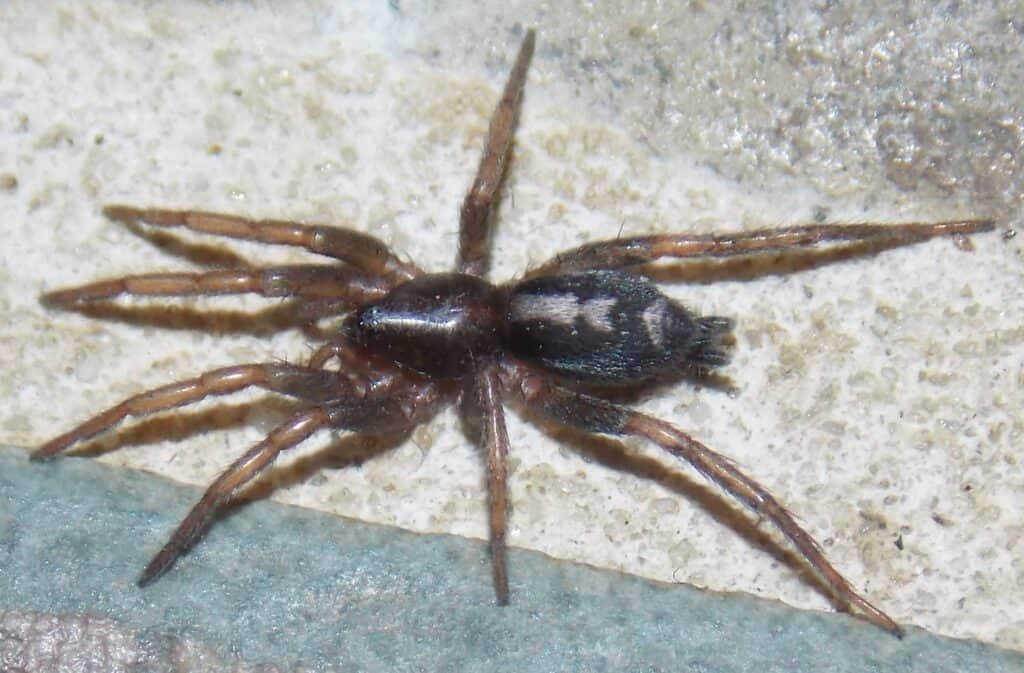
A distinguishing feature of this spider is a white mark on its back, which is why it’s commonly known as the “parson spider.”
©Fyn Kynd/Flickr – License
5. Black and Yellow Garden Spider (Argiope aurantia)
The Argiope aurantia spider is a beautiful and eye-catching arachnid that is commonly seen during the late summer season in Louisiana.
It has a small cephalothorax with silver hairs and a slightly oval, yellow and black patterned abdomen, featuring a black mid stripe with four white spots in the center. Its legs are black with yellow-orange stripes and a solid orange-yellow upper portion.
Females of the species measure between ¾ to 1 inch, while males are approximately ¼ inch in size.
With a unique circular shape, black and yellow garden spiders weave stunning webs that can measure up to 2 feet in diameter. And as their name implies, these spiders prefer to inhabit sunny and unobstructed areas such as gardens and fields.
Black and yellow garden spiders are beneficial to gardeners. In fact, they serve as natural pest controllers by frequently preying on insects like stinkbugs and Japanese beetles.
Although black and yellow garden spiders may bite if provoked, the venom they produce is harmless to most non-allergic individuals, causing only mild pain akin to the sting of a bee. However, if you are allergic, seek medical attention immediately if bitten by a spider.
Fun Facts
- Female black and yellow garden spiders tend to remain in one location for most of their lives.
- The black and yellow garden spider is famous for maintaining a neat and organized web.
- These spiders can be found across a vast range, spanning from Canada all the way to Costa Rica.

Black and yellow garden spiders serve as natural pest controllers by frequently preying on insects like stinkbugs and Japanese beetles.
©iStock.com/AwakenedEye
6. Northern Black Widow (Latrodectus variolus)
The northern black widow spider, infamous for its venomous bite, can be located in both residential and urban regions of Louisiana.
The northern black widow spider can be identified by the distinctive red markings on its black abdomen. The split or “broken” red hourglass on the belly is a key feature that distinguishes it from the southern black widow. “
Females are larger than males, with a body length of half an inch and a total length of 1 ½ inches, including the legs.
This species of black widow is closely linked to its southern and western counterparts. Female black widows are known to be sexually predatory and construct robust three-dimensional webs in their natural habitat.
Northern black widow spiders are not only limited to natural habitats. They can also thrive in human-made structures such as colonial stone walls and woodpiles. These arachnids also live in places such as greenhouses or attic spaces.
The primary diet of black widow spiders consists of insects. However, they also consume other creatures, such as woodlice, diplopods, and other arachnids.
Female northern black widows have less toxic venom than their southern counterparts. But with that said, if you are bitten, you can still expect a lot of pain and swelling. On the other hand, male black widows have a distinct pattern and are not considered dangerous to humans.
Fun Facts
- The northern black widow has a lifespan of approximately 1 to 3 years.
- They can be found in areas ranging from southeastern Canada to northern Florida.
- Fortunately, these venomous spiders are not aggressive and tend to avoid contact with humans.
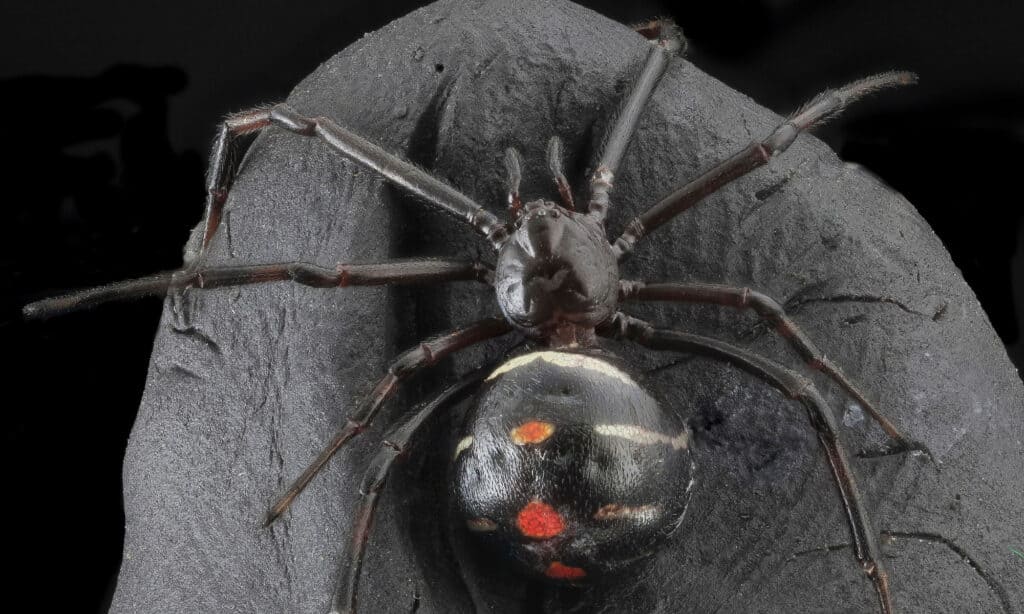
Unlike other black widows, northern black widows have a broken hourglass-shaped marking on their abdomens.
©Porco_Rosso/Shutterstock.com
The photo featured at the top of this post is © iStock.com/AmericanWildlife
Thank you for reading! Have some feedback for us? Contact the AZ Animals editorial team.






